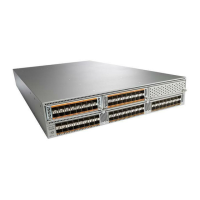PurposeCommand or Action
Updates the membership information of the interface to reflect
the changed VSAN.
switch(config-vsan-db)# vsan vsan-id {fc slot/port
| vfc vfc-id}
Step 5
To remove the VSAN membership of a FC or vFC
interface, assign the VSAN membership of that
interface to another VSAN. Cisco recommends that
you assign it to VSAN 1.
Note
Displaying VSAN Static Membership
To display the VSAN static membership information, use the show vsan membership command.
The following example displays membership information for the specified VSAN:
switch # show vsan 1 membership
vsan 1 interfaces:
fc2/1 fc2/2 fc2/3 fc2/4
san-port-channel 3 vfc1/1
Interface information is not displayed if interfaces are not configured on this VSAN.Note
The following example displays membership information for all VSANs:
switch # show vsan membership
vsan 1 interfaces:
fc2/1 fc2/2 fc2/3 fc2/4
san-port-channel 3 vfc3/1
vsan 2 interfaces:
fc2/3 vfc4/1
vsan 7 interfaces:
vsan 100 interfaces:
vsan 4094(isolated vsan) interfaces:
The following example displays static membership information for the specified interface:
switch # show vsan membership interface fc2/1
fc2/1
vsan:1
allowed list:1-4093
Default VSANs
The factory settings for Cisco SAN switches have only the default VSAN 1 enabled. We recommend that you
do not use VSAN 1 as your production environment VSAN. If no VSANs are configured, all devices in the
fabric are considered part of the default VSAN. By default, all ports are assigned to the default VSAN.
VSAN 1 cannot be deleted, but it can be suspended.
Up to 256 VSANs can be configured in a switch. Of these, one is a default VSAN (VSAN 1), and another
is an isolated VSAN (VSAN 4094). User-specified VSAN IDs range from 2 to 4093.
Note
Cisco Nexus 5000 Series NX-OS SAN Switching Configuration Guide, Release 5.2(1)N1(1)
OL-27583-01 123
Configuring and Managing VSANs
Guidelines and Limitations for VSANs

